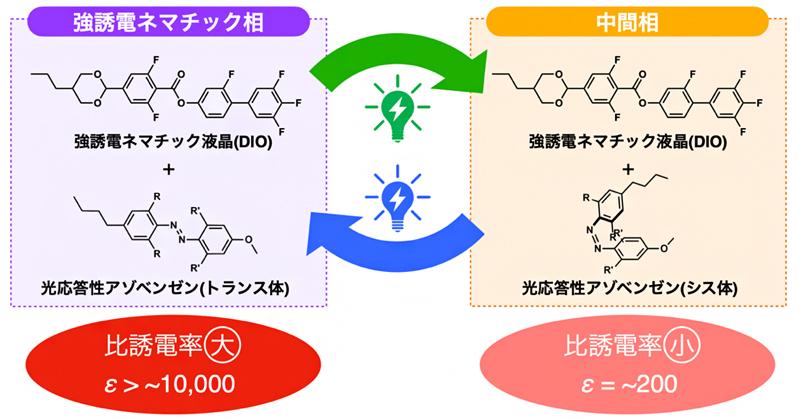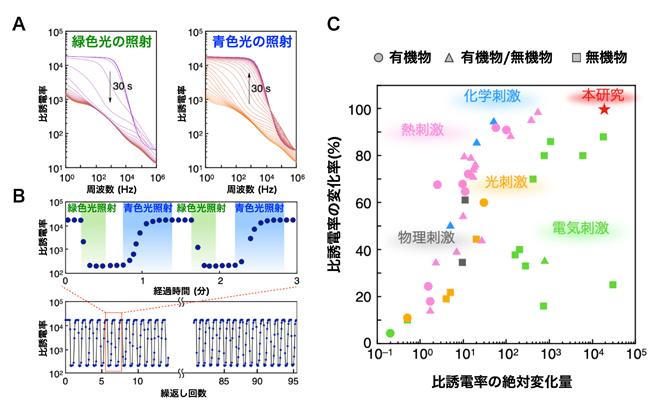
LCD vulgarisen that can significantly control the dielectric dielectric rate with light
RIKEN
-Expectations for applying to a photo capacitor element that only sandwiches with electrodes-
RIKEN(理研)創発物性科学研究センターソフトマター物性チームの西川浩矢特別研究員、荒岡史人チームリーダーらのResearch teamは、「強誘電性[1]」を持った「ネマチック液晶[2]」に光応答性を付与し、光によって比誘電率[3]を広範囲にわたって制御できる材料を開発しました。
本研究成果は、強誘電体[1]の比誘電率を大幅に、簡便かつ可逆に制御する原理を発案しただけでなく、強誘電性ネマチック液晶を用いた実用的なフォトコンデンサ素子への応用が期待できます。
Futeline Nematic LCDs are a new concept LCD with a series of reports in recent years, and have been reported with more than 10,000 hypoelectric rates for organic molecules.However, the origin of this fantastic electricity was still unknown, and the possibility of application was unknown.
This time, the research team responds to visible light and changes the ratio rate of about 100 times in a very simple method of adding a small amount of organic molecules with light response to the material of the ferrous nematic liquid crystal.Developed.Furthermore, it has been shown that a photo capacitor element can be made using this material, and the capacity capacity can be significantly controlled and controlled.
This study was published in the online scientific magazine "Nature Communications" (March 3rd ︓ Japan 3rd 3rd).
A mechanism that dramatically changes the ratio rate by light irradiation
background
「強誘電性」は不揮発性メモリ[4]などさまざまな素子の原理として用いられる重要な物性で、空間対称性[5]の破れた物質だけに発現する特殊な性質を持ちます。強誘電性の多くは結晶など固体状態で現れますが、近年では、「ネマチック液晶」と呼ばれる高い流動性を持った状態の有機物においても強誘電性が報告されており、有機物としては最大級の10,000を超える比誘電率が確認されています。
ネマチック液晶は光シャッター[6]として利用できることから、スマートフォンやテレビなどの表示素子に広く用いられています。しかし、強誘電性を持つネマチック液晶はごく最近になって発見され、固体材料にはない流動性・柔軟性を持つことから、表示素子にとどまらず、広くエネルギー材料やロボティクス材料への活用の可能性から注目されています。その一方で、その強誘電性の発現原理は未解明であるため、基礎科学研究が行われています。
Imaging elements such as digital cameras, solar cells, and light detection sensors are often used with materials and elements that respond to light.There are various principles in these materials and elements. For example, semiconductors such as the light called "photo register" that gives light response and change the electric resistance, and a semiconductor such as a diode element that generates electricity called "photo diode".There is something that uses the material (Fig. 1).On the other hand, there are elementary capacitors that store and release electricity, but there are not many examples of "photo capacitors" that can respond lightly, and the existing photo capacitors have not changed significantly due to light response.。
Figure 1 Comparison of conventional photo registers, photo diodes and photo capacitors
A comparison between the electric element (photo register, photo diode) that responds to the light that has been realized so far and the photo capacitor.The circuit symbol of the photo capacitor was invented by the symbol of the Hikari response element so far.
Research methods and results
Research teamは、強誘電性ネマチック相を示す含ジオキサンフッ素系液晶性化合物のDIOと呼ばれる材料(図2上)に、光応答性を持つ有機分子を少量添加するという極めて簡便な方法で、可視光に応答し比誘電率がおよそ100倍も変化する材料を開発しました。添加した光応答性分子には、強誘電性ネマチック液晶に対する高い混合親和性を持ちながらも、可視光によって光異性化反応[7]を示すアゾベンゼン基[7]を持つ色素(通称Azo-F)を新たに合成しました(図2下)。

Figure 2 Light response federation of electricity Nematic LCD mixture developed this time
Chemical structure of molecules used in this study.The newly synthesized azobenzene pigment AZO-F (bottom) was added as the main material using the ferrous electric nematic LCD DIO (top).
Azo-Fを添加した強誘電性ネマチック液晶は、波長500~550ナノメートル(nm、1nmは10億分の1メートル)の緑色の光を照射すると比誘電率が減少し、波長400~450nmの青色の光を照射すると比誘電率が増加しました。Azo-Fを4%混合した強誘電性ネマチック液晶では、光照射前の比誘電率は最大値で約18,000(εmax)でしたが、緑色の光(波長525nm、180mW cm-2)を30秒照射することで、最小値で約200(εmin)まで下げることができました(図3A)。この状態に青色の光(波長415nm、7mW cm-2)を30秒照射すると、比誘電率は最大値である18,000にほぼ戻り、このときの比誘電率の変化率(εmax-εmin)/εmaxは99.5%にも達しました。この変化率は、光だけでなく熱や電場など各種外部刺激に応答する従来の誘電体[1]材料の中で最大です(図3C)。
In addition, by alternately irradiating green and blue light, this change could be repeated, and it was possible to repeat it many times (confirmed up to 100 times) (Fig. 3b).As for the response time, the same change was obtained in less than a few seconds by using stronger light such as lasers.
Fig. 3 Changes in Hyoki College due to light irradiation
次に、光による状態変化を紫外-可視吸収分光測定[8]やX線回折法[9]、偏光顕微鏡[10]観察により解析した結果、緑色の光を照射したときにはAzo-Fが「シス体」と呼ばれる嵩高い状態に光異性化することで、強誘電性ネマチック液晶の配向秩序に擾乱を与え強誘電性の分極構造を破壊し、強誘電性ではない通常のネマチック液晶に相転移[11]していることを確認しました。一方、青色の光を照射したときには、Azo-Fは「トランス体」という親和性の高い状態に光異性化することで、強誘電状態を復元することが分かりました。これは、強誘電性ネマチック液晶では、分子の局所的な配向構造が強誘電性の発現に関わっていることを示しています。
Since the fermentation nematic liquid crystal has a fluidity, it can spread between the electrodes simply by sandwiching between the flat electrodes, and a parallel plate capacitor can be configured.Since the power storage capacity of the ideal capacitor is proportional to the ratio rate, the capacitor using a ferrous electric nematic liquid crystal has about 1000 times larger than the case where the normal nematic LCD is sandwiched in the same way.I have (Fig. 4).
コンデンサの電極材として、可視域において光透過性を持つインジウム・スズ酸化物半導体(ITO)[12]を用いると、素子の内部、つまり光応答性の強誘電性ネマチック液晶まで光を届けることができます。従って、コンデンサの静電容量は緑色、青色の光の照射による比誘電率の変化に応じて増減させることができ、フォトコンデンサが実現できます。
Figure 4 Outline of parallel flat plate capacitors using a liquid crystal
そこで、平坦なITO電極に光応答性強誘電性ネマチック液晶を挟んだだけの「液晶セル」と呼ばれるシンプルな原理デバイス(電極面積50mm2、電極間距離17.8マイクロメートル[µm、1µmは1000分の1mm])では、静電容量を約4ナノファラッド(nF、1nFは10億分の1ファラッド)から360nFにわたって光制御できることを確認しました(図5)。静電容量の絶対値はコンデンサ電極の面積および距離によっても変わりますが、材料を電極に挟んだだけの簡単な素子にもかかわらず静電容量がnF~µF(1µFは100万分の1ファラッド)と、広く使われる実用的なコンデンサと同程度の範囲にあることは、工業的に大きな利点になると考えられます。
Fig. 5 Outline of photo capacitors and control of electrostatic capacity due to visible light irradiation
The photo capacitor can be produced simply by injecting a mixture of ferrous electric nematic and light response azobenzene pigment into the liquid crystal cell.
さらに、実用状態に近い電気回路での動作を確認するために、このフォトコンデンサを電気発振回路[13]へ組み込み、光照射下での動作を調べたところ、100Hz~8.5kHzの範囲で発振周波数を変化させることができました。この周波数は人間の可聴範囲にあるため、発振回路をスピーカーに接続することで、発振周波数の変化を音の高低変化として捉えられます(動画参照)。100Hz~8.5kHzの動作周波数範囲は上記の4nF~360nFの静電容量変化に対応しますが、動作限界周波数はこの外側にあると考えられます。従って、少なくともこの範囲では正常なコンデンサとして動作し、また光によって自在に制御できることを示しています。
There is no narration in this video
Future expectations
The light response nematic liquid crystal, which has been realized this time, can be expected to achieve various optical elements unprecedented due to its exceptional light response.The photo capacitor shown as an example can be a simple structure, but it can run between high -capacity and low -capacity status by light irradiation, so a new electrical element, such as a storage device that can freely change the output power according to the power demand.It can be an element technology of.
In this study, we used materials that require heating, but the ferrous electric nematic LCD that can be used at room temperature has already been developed, and a photo capacitor that operates at room temperature can be realized by using it.Furthermore, since the basic element structure is the same as the liquid crystal display, there is also a possibility that existing LCD technology and industrial base can be used.
supplementary explanation
Research team
RIKEN創発物性科学研究センターソフトマター物性チーム特別研究員 西川 浩矢(にしかわ ひろや)チームリーダー 荒岡 史人(あらおか ふみと)創発生体関連ソフトマターResearch team基礎科学特別研究員(研究当時) 佐野 航季(さの こうき)(現 信州大学助教)
Original Society Information
Presenter
RIKEN 創発物性科学研究センター ソフトマター物性Research team特別研究員 西川 浩矢(にしかわ ひろや)チームリーダー 荒岡 史人(あらおか ふみと)
In charge of the press
RIKEN 広報室 In charge of the pressInquiry form
Inquiries regarding industrial use
Inquiry form
